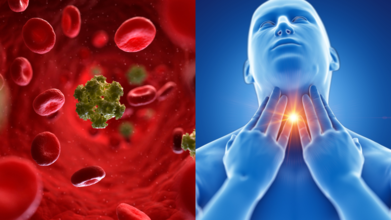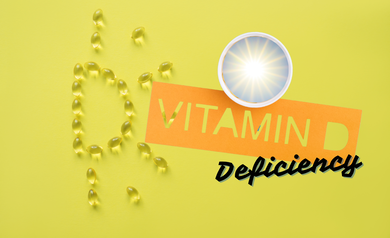- Health Conditions A-Z
- Health & Wellness
- Nutrition
- Fitness
- Health News
- Ayurveda
- Videos
- Medicine A-Z
- Parenting
- Web Stories
6 Surprisingly Cool Benefits of Taking a Cold Plunge

We know. We know. Willingly dipping yourself into freezing water is not everyone's idea of a good time. In fact, it’s the stuff most nightmares are made of. But people are queuing up to do it. Whether it’s a tub full of ice cubes or a freezing lake at 6am, cold plunges are a thing. While you will be surprised to know the benefits, first know what exactly happens when you put your body through this temporary torture.
From giving your mood a caffeine-free lift to helping muscles relax, here's what makes cold plunging the icy wellness trend for your body and brain.
1. Boosts Your Mood
A few minutes in icy water can deliver a euphoric high. That’s because cold exposure triggers a rush of endorphins, your body’s natural feel-good chemicals. It also reduces cortisol, the stress hormone. Some studies even suggest that cold water immersion can help ease symptoms of depression and anxiety.
2. Recovers Muscles
Ever wonder why athletes dunk themselves in icy baths post-game? Cold plunges help reduce inflammation, speed up muscle recovery, and soothe soreness. When you expose your body to extreme cold, blood vessels constrict. Once you’re out and warming up, they dilate, increasing blood flow to tired muscles.
3. Improves Sleep
Taking a cold plunge can actually help you sleep better. Post-immersion, your body enters a state of deep relaxation once it warms back up. Your nervous system settles down, and your sleep hormones kick in more efficiently.
4. Boosts Immune System
Regular cold plunges may also give your immune system a little kick in the pants. The cold stimulates white blood cell production, which helps your body fight off illness. Some studies have found that people who practise cold water immersion regularly tend to get fewer colds and recover faster.
5. Makes Your Skin Glow
Cold water tightens your pores, reduces puffiness, and boosts circulation to your skin. It’s basically nature’s version of a toner. Plus, by reducing inflammation and flushing out toxins, your skin is left looking brighter, fresher, and decidedly more awake than you feel.
6. Teaches You to Breathe
Ever tried to breathe normally when your body is screaming from shock? Cold plunges force you to master your breath. That slow, deep breathing you’re encouraged to do during the first freezing minute? It’s not just to stop you from panicking. It actually helps train your nervous system to stay calm under pressure, build mental resilience, and reduce anxiety over time.
In a nutshell, cold plunging isn’t just a weird wellness trend. It’s a full-body and mind experience that comes with some genuinely impressive health benefits. Yes, it’s uncomfortable. Yes, you’ll want to scream. But after a while, you might just find yourself looking forward to it.
World Head and Neck Cancer Day: This Common Virus Is Now The Top Cause Of Oropharyngeal Cancer In Men

When we think of human papillomavirus (HPV), the first association that comes to mind is cervical cancer. That link is well established. But what most people don’t realise is that HPV has now quietly become the leading cause of a completely different and rapidly rising cancer—oropharyngeal cancer—particularly in men. These cancers, which fall under the broader umbrella of head and neck cancers, often strike parts like the tonsils and the base of the tongue.
On World Head and Neck Cancer Day, experts are ringing the alarm bells: it’s time we start talking about HPV in men with the same urgency that we do for women.
More Men, More Risk
According to a 2023 study published in The Lancet Oncology, HPV-related oropharyngeal cancers are now five times more common in men than women. “This isn’t just a medical statistic; it’s a warning signal,” says Dr. Akash Tiwari, Consultant, Oral and Maxillofacial Surgical Oncology. “We’re seeing a sharp increase in these cases, particularly in high-income countries, and the common link is persistent high-risk HPV infection.”
What’s making men so vulnerable? For starters, transmission. Oral HPV is most commonly passed during intimate skin-to-skin contact, especially through oral sex. Although most HPV infections clear up on their own, some high-risk strains like HPV-16 can hang around silently in the tissues of the throat and, over time, turn cancerous.
Why Men Struggle to Fight It Off
“Biologically, men are more likely to contract oral HPV and less likely to clear the infection,” explains Dr. Aarzoo Saliya, Consultant ENT, Head and Neck Onco Surgeon. “It may come down to immune differences, sexual behaviour patterns, or even lack of awareness.”
Unlike many infections that cause noticeable symptoms, oral HPV is sneaky. It often produces no signs, which means people can be completely unaware they’re carrying it or, worse, passing it on. And when symptoms do show up, they’re usually vague, making early diagnosis tough.
Symptoms You Should Watch For
HPV-related oropharyngeal cancer doesn’t always scream for attention. But if you’ve had any of these signs persistently, it might be time to get checked:
- A constant sore throat that just won’t quit
- Difficulty swallowing
- A lump or swelling in the neck
- Changes in your voice
- Unexplained ear pain
“These aren’t symptoms people usually rush to a doctor for,” says Dr. Tiwari. “But in the context of HPV-related oropharyngeal cancer, they’re red flags.” Unlike traditional tobacco- or alcohol-related oral cancers, HPV-related cases often don’t present with obvious visible lesions, which adds to the challenge.
Prevention Starts Early
The good news is that we can prevent it. The same HPV vaccine that’s widely recommended for cervical cancer prevention in girls works just as well to prevent the strains of HPV that cause oropharyngeal cancer.
“The most effective way to reduce risk is through timely vaccination,” says Dr. Saliya. “Ideally, the vaccine should be given before someone becomes sexually active; that’s why it’s recommended at ages 11 or 12 but can still be taken up to age 26 if missed earlier.”
Yet, in many places, the uptake of the HPV vaccine among boys remains painfully low, mostly because the risk in men hasn’t received the same attention.
Changing the Conversation Around HPV
There’s also a major need to shift public perception. “HPV isn’t just a ‘women’s issue’, and it certainly isn’t just about cervical cancer,” Dr. Tiwari stresses. “It’s a sexually transmitted virus that can affect everyone, and the consequences for men are becoming increasingly clear.”
That means raising awareness around safe sexual practices, routine screenings for those at risk, and greater openness about male HPV-related health risks. Men, particularly young adults, need to be part of the vaccination narrative.
Know the Risks, Take Action
On a day that spotlights head and neck cancers globally, the message is simple but urgent: HPV-related oropharyngeal cancer in men is real, rising, and largely preventable. Ignoring it isn’t just unwise; it’s dangerous. Whether you’re a parent considering the HPV vaccine for your son, a man experiencing persistent symptoms, or someone simply unaware of how far-reaching HPV’s impact can be, now’s the time to pay attention. Early action, education and vaccination can quite literally save lives.
Weight Loss Drugs For Dementia – Study Finds It May Prevent Cognitive As Well As Cardiovascular Issues

(Credit-Canva)
Weight loss drugs have become wildly popular in the recent years. However, even though they are popularly known as weight loss drugs they are actually used for a separate purpose, weight loss is just a side effect of the medication.
Medications like Ozempic and Zepbound, which are primarily used to treat type 2 diabetes and help with weight loss, are showing exciting new potential. They might also be helpful for a wider range of health conditions, from sleep apnea to chronic kidney disease.
Diabetes and Weight Loss Medicines
A recent study published in the JAMA Network Open suggests that these kinds of medications, known as GLP-1 receptor agonists, could offer important protection beyond their usual uses. For people who have both obesity and type 2 diabetes, these drugs might lower their risk of death and reduce the chances of developing two serious brain problems: dementia and a common type of stroke.
The findings suggest that GLP-1 drugs could do more than just control blood sugar, help with weight loss, and support heart health; they might also directly protect the brain and its blood vessels.
What the Research Discovered
Scientists had already hinted that GLP-1 drugs might help protect against dementia and stroke. However, there hadn't been many big studies specifically looking at how these drugs affect brain health, especially in people with a high risk, like those who have both type 2 diabetes and obesity.
To help answer these questions, researchers looked at seven years of health information from over 60,000 people. All of these individuals had both type 2 diabetes and obesity. Some of them were taking older diabetes medications, while others were prescribed GLP-1 drugs, like those found in popular medications.
After carefully checking the connections between the medicines and various brain conditions, the scientists found some significant things. People taking a GLP-1 drug had:
- A 37% lower chance of developing dementia.
- A 19% lower chance of having an ischemic stroke, which is the most common kind of stroke, caused by a blocked blood vessel in the brain.
- A 30% lower chance of dying from any cause.
The protection against dementia seemed even stronger for women over 60 and for those with a specific body mass index (BMI) range. An expert noted that people in this group have a particularly good chance to improve their brain health. It's important to know that these GLP-1 drugs did not seem to lower the risk of Parkinson's disease or another type of stroke called hemorrhagic stroke, which happens when there's bleeding in the brain.
Important Things to Consider
This study adds to the growing evidence that GLP-1 receptor agonists are very helpful tools, not just for losing weight and managing diabetes, but possibly for brain health and thinking abilities too.
However, it's really important to understand that this kind of study only shows a link, not that the drug directly causes the protection. It's possible that other things, like people's daily habits, could have played a role in the results, not just the medication itself.
Also, the researchers didn't collect detailed information like blood markers, genetic data, or brain scans. Having this kind of information could give much deeper insights into what's actually happening inside the body. The main researcher emphasized that these findings should be looked at carefully and need to be confirmed by more strict studies before doctors start making official recommendations based on them.
This Common Deficiency Could Raise Your Risk Of COVID-19 Infection

Credits: Canva
Scientists are investigating whether vitamin D frequently touted for its use in maintaining bone health, could also prevent serious COVID-19 complications. A new study published in the peer-reviewed journal PLOS One illuminates this potential, finding that individuals with vitamin D deficiency were 36% more likely to need hospitalization from COVID-19.
The findings point toward a connection between immune resilience and vitamin D levels, even though the data stops short of proving that supplementation can directly reduce the severity of COVID-19. Still, it’s a significant insight in the ongoing effort to identify who remains vulnerable as the world learns to live with the virus.
“We found people with low vitamin D weren’t necessarily more likely to catch COVID-19,” said lead researcher Kerri Beckmann, a senior research fellow at the University of South Australia. “But if they did get infected, their odds of serious illness and hospitalization were notably higher.”
The study tapped into the vast UK Biobank dataset, analyzing health information from over 150,000 participants. Researchers stratified the data by vitamin D levels and tracked COVID-19 outcomes, including infection rates and hospitalization.
Low levels of vitamin D were not associated with a higher risk of acquiring COVID-19. When infected, however, those lacking vitamin D were much more likely to develop severe illness necessitating hospitalization.
It’s an important distinction. While vitamin D won’t necessarily prevent you from contracting COVID, having adequate levels may improve how your body handles the virus similar to how a vaccine booster might reduce the severity of symptoms.
“Vitamin D plays a key role in regulating the immune system, so it’s plausible that low levels may influence how the body responds to infections,” Beckmann explained.
How Common is Vitamin D Deficiency?
Surprisingly prevalent. Based on a 2022 study appearing in Frontiers in Nutrition, approximately 22% of Americans are deficient in vitamin D. The rate is even greater among some groups, including individuals with darker skin tone, those who reside in the northern latitudes, and those who have restricted sun exposure because of lifestyle or chronic disease.
Vitamin D is sometimes referred to as the "sunshine vitamin" because our bodies produce it by exposing our skin to sunlight. But diet and supplements can also contribute to keeping levels healthy.
Benefits of Vitamin D
The worth of Vitamin D reaches far beyond the COVID-19 pandemic. It's needed for:
Bone health: Vitamin D allows your body to absorb calcium. Without sufficient levels of it, bones become brittle and cause issues such as osteoporosis in adults and rickets in children.
Immune modulation: It assists in modulating innate and adaptive immune reactions — two pillars of your body's defense against disease-causing organisms.
Inflammation regulation: Low blood levels have been associated with higher inflammation, which can lead to worse COVID respiratory outcomes.
And although scientists are hesitant to overhype the value of supplements, it's obvious that having healthy vitamin D levels is part of a larger picture of immune support.
Should You Start Taking Vitamin D Supplements?
Not so fast. Experts, including those involved in the study, stress that while the findings are compelling, they do not confirm that vitamin D supplements alone can prevent hospitalization from COVID-19.
“This is an area worth exploring further, but it’s too early to say supplementation is a silver bullet,” Beckmann noted. “Many people with poor overall health also have low vitamin D levels, which complicates the picture.”
That said, for people at risk of deficiency — including older adults, people with limited sun exposure, and those with darker skin — checking vitamin D levels with a healthcare provider could be a smart step, especially if they’re concerned about COVID outcomes.
How to Boost Your Vitamin D?
There are three main sources of vitamin D:
Sunlight: Just 10 to 30 minutes of mid-day sunlight several times a week may be enough for many people, depending on skin tone, geography, and season.
Diet: Not many foods provide vitamin D naturally. The richest sources from food are fatty fish such as salmon, sardines, mackerel, and trout; egg yolks; mushrooms; and fortified foods such as milk or cereal.
Supplements: If your doctor finds a deficiency, they may suggest a daily supplement. Most adults require 600 IU (15 mcg) daily, while people over 70 need 800 IU (20 mcg).
Be careful with the dosage — too much vitamin D can be toxic and cause such complications as kidney damage.
Where Do We Go From Here?
While COVID-19 is no longer the emergency it once was, the virus still circulates and continues to cause complications — especially among vulnerable populations. Knowing that vitamin D levels may influence how someone fares with an infection opens the door to more targeted prevention efforts.
That might include screening for deficiency in high-risk groups, public health messaging around safe sun exposure, or considering fortified foods in communities with higher rates of deficiency but more research is needed. Clinical trials will be crucial in determining whether vitamin D supplementation could become a recommended part of COVID-19 care protocols. For now, maintaining healthy levels is simply good preventive medicine.
The latest study doesn't claim that vitamin D is a cure for COVID-19. But it adds to a growing body of evidence suggesting that micronutrient deficiencies can shape how our bodies respond to viral infections.
In a post-pandemic world where we're learning to coexist with SARS-CoV-2, this kind of insight is valuable — not just for COVID, but for broader public health. As Beckmann summed it up: “COVID may not be the threat it once was, but understanding who is still at risk, and why, will help us stay a step ahead.”
© 2024 Bennett, Coleman & Company Limited

